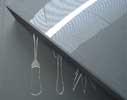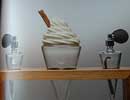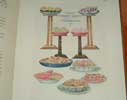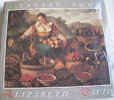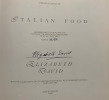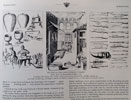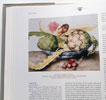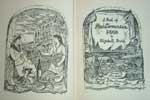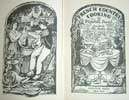Dali.
Salvador
With a beautiful lithograph hand-signed by Dali in pencil.
DALI: THE WINES OF GALA.
Translated from the French by Olivier Bernier.
Published by Harry N. Abrams Inc. 1978, New York.
FIRST EDITION. 4to. 216 x 305 mm. Inside cover with double page portrait of Dali. 1fep. Half Title. Double page Title. Verso with printer info. p 5-7. Contents. p 8-11 Intro; La Cave. (10-16). p 16-293. p 294-296 Guide to more than 140 illustrations, including 124 in full colour. Original white silk cloth hardcover. With titles in gilt and multi-colour. Dali design to front cover. A near fine copy in very good gold embossed jacket. ITEM 2. 493 x 276 mm. A lithograph of the 'King of Cup Hand' Tarot suite. [Ref: The official catalogue of the graphic works of Salvador Dali by Albert Field]. Hand signed in pencil by Dali. Also numbered 'EA' (Epreuve d' Artiste). Housed in a marbled paper folder. To accompany the 'Wines of Gala'.
-
The 'Wines of Gala' is an extravagant production, eccentric and personal by the great Spanish surrealist, Salvador Domenech Felipe Jacinto Dali. As a follow-up to his phenomenal best-selling cookbook 'Les dîners de Gala', it's in this delightfully eccentric guide to wine, the surrealist master shares his passion for the gift of the gods. The book explores the many myths of the grape, in texts and sensuous, subversive works by the artist, always true to his maxim: “A real connoisseur does not drink wine but tastes of its secrets.” Dali's take on pleasures of the grape and the book sets out to organize wines "according to the sensations they create in our very depths." Through eclectic metrics like production method, weight, and colour, the book presents wines of the world in such innovative, Daliesque groupings such as "Wines of Frivolity," "Wines of the Impossible," and "Wines of Light". The significant wine regions are, 'Dix Vins du Divin' [ten Divine Wines] that Dali highlights including descriptions of the wines of Ay, Shiraz, King Minos, Lacrima Christi, the Great Red Bordeaux, Châteauneuf-du-Pape, Romanée Conti,
Sherry, Châteaud’Yquem, and California wines. Bursting with the imagery of the 140 fantastic illustrations by Dali, many of which are appropriated artworks, including various classical nudes, all of them reconstructed with suitably Surrealist, provocative touches, like Jean-Francois Millet's 'The Angelus', one of Dali's favourite points of reference over the decades. Dali also included what is now considered one of the greatest works from his late "Nuclear Mystic" phase, 'The Sacrament of the Last Supper' (1955), which sets the iconic biblical scene in a translucent dodecahedron-shaped space before a Catalonian coastal landscape. Dali was by this stage a devout Catholic, simultaneously captivated by science, optical illusion, and the atomic age. Rather than any prescriptive classification, the book is a flamboyant, free-flowing manifesto in favour of taste and feeling, as much as a multisensory treat, also a full-bodied document of Dali's late-stage oeuvre, in which the artist both reflected on formative influences and refined his own cultural legacy. Wines of Gala was published in 1977, first in French, as 'Les Vins de Gala et du Divin' by Draeger, then in English by Abrams in New York a year later. Dedicated to Dalí’s long-time wife and muse, Gala, an imperious Russian woman 10 years his elder. The book covers Dalí’s famously intense obsession with sexuality and desire for food and wine, three sensual topics he’d rarely addressed in his work. But while the earlier cookbook has grown in notoriety and acclaim since it went out of print, reliably selling for hundreds of dollars whenever a used copy turns up, 'Wines of Gala' sank beneath the surface, an afterthought at the tail end of the 20th-century master’s career. How-ever a full reprint of the 1st edition published by Taschen in November 2017 changed all that. The book became the winner of the 2018 Gourmand World Cookbook Awards, causing this second book of Dali's to be as sought after as his first one. A fine addition to a gastronomic library, made all the more collectable with the accompanying large, expanded sized lithograph of the tarot card, hand-signed by Dali. (image #5 below). The cards were designed by Dali and first published in a 1984 limited edition box set of 78 cards, each dazzling in colour, that has since long been sold out.
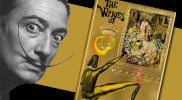

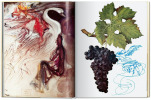
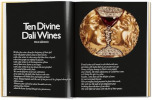


|
|

Modern category
ref number:
11300
|








